If you love big power, bold design, and a manual gearbox that fights back a little, the Dodge Viper needs no introduction. The icon bowed out after 2017, but whispers keep circling that a 2026 dodge viper could slither back onto the scene. Dodge hasn’t officially announced a new Viper. That means everything below is informed analysis, not confirmation. Still, based on Stellantis’ current powertrains, platform strategy, and where the performance market is going, we can sketch a believable picture of what a modern Viper revival might be—and how it could be positioned to take on Corvette, 911, and the wave of electrified rivals.
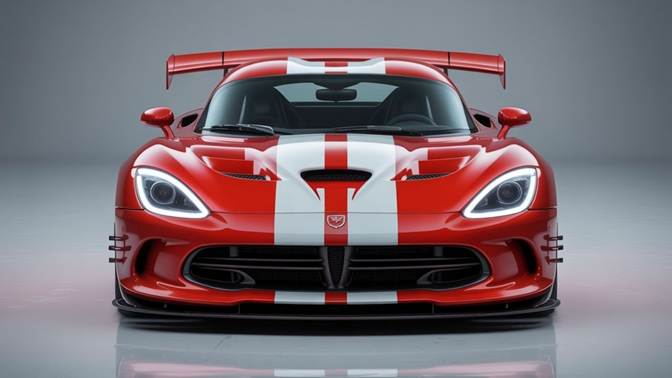
No official 2026 Dodge Viper announcement as of now; everything here is projected or speculative. Lightweight, analog-feeling super‑coupe with serious aero, not a plush grand tourer. Twin‑turbo “Hurricane” inline‑six (ICE), a high‑output hybrid, or a low‑volume EV halo—each with pros and cons. A manual would be the people’s choice; a Tremec 8‑speed DCT is the realistic “modern” option if emissions/packaging force it. 110,000–110,000–140,000 to start; ACR‑style track variants from ~$160,000+. Reveal late 2025, limited 2026 model‑year production—this is the most optimistic scenario.
What’s official vs. what’s Rumor
Officially known:
- Viper production ended after 2017 at the Conner Avenue Assembly plant, which no longer builds cars.
- Stellantis (Dodge’s parent) is pivoting to electrified platforms while still offering high‑output ICE (e.g., twin‑turbo 3.0L “Hurricane” inline‑six) in select products.
- Dodge’s new Charger Daytona EV and twin‑turbo ICE models define the brand’s near‑term performance focus.
Rumor/analysis
- A 2026 viper would need a new assembly plan and a compliance path for crash and emissions rules.
- If revived, expect a lighter, more precise Viper—less brute V10, more precision weapon—with modern aero, cooling, and braking.
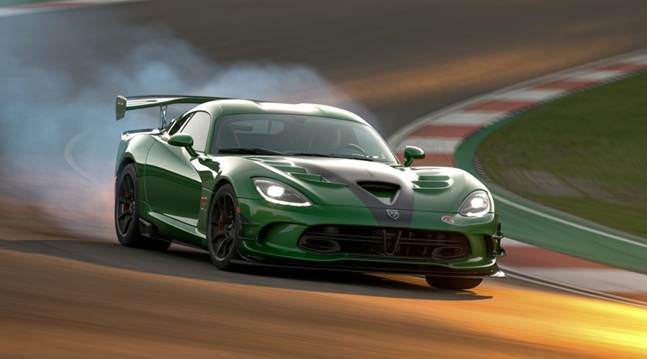
2026 Dodge Viper New Redesign
If Dodge brings the Viper back, don’t expect a nostalgia costume. Expect a clean‑sheet redesign built around today’s realities: weight targets, aero efficiency, and heat management for turbo or hybrid hardware.
- Body and aero: Long hood/short deck proportions, side‑exit exhaust vibes (if ICE), big‑mouth cooling, and an aero package that actually works—splitters, diffusers, and an available active rear wing on track trims.
- Structure: An aluminum spaceframe or mixed‑material tub with more carbon fiber than ever. Full carbon monocoques are expensive; a hybrid approach is more likely at this price.
- Cooling: Hood extractors, fender vents, and brake ducts that are more race‑car than show‑car.
- Weight: Target curb weights starting in the 3,300–3,600 lb range depending on powertrain. The old V10 cars were heavy; the new one would need to go the other way.
- Steering and brakes: Hydraulic‑feel steering is unlikely, but a quick‑ratio electric system could be tuned for feel. Massive iron rotors standard; carbon‑ceramics optional or standard on ACR‑style trims.
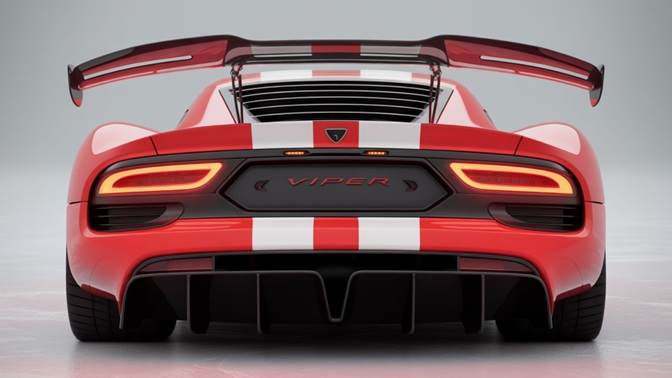
Concept 2026 2026 Dodge Viper
A concept would almost certainly debut first, telegraphing stance, aero, and cockpit layout without all the production constraints. Wide, planted, with muscular rear haunches and a low cowl for sightlines. Thin LED signatures, motorsport‑style rear light bar, and functional lighting for visibility at speed. Two seats, deep sills, a fighter‑jet dash with a small, high‑contrast cluster and a low, wide center screen that keeps your eyes up. Bare carbon, Alcantara, anodized metal, and real switches for essential functions—Viper was always more race shop than jewelry store.
2026 Dodge Viper Powertrain
The heart of the matter. There’s no way a modern Viper returns with the old naturally aspirated V10. Here are three realistic pathways Dodge could take, with trade‑offs.
Scenario A: Pure ICE, twin‑turbo inline‑six (most feasible ICE)
- Engine: Stellantis “Hurricane” 3.0L twin‑turbo I6
- Output targets: 520–620 hp (base to track trim)
- Drivetrain: Rear‑wheel drive, mechanical limited‑slip differential
- Transmission: 6‑speed manual (dream) or 8‑speed dual‑clutch (likely for emissions/performance)
- Pros: Weight and sound drama with old‑school driving feel; less complexity than hybrid
- Cons: Harder to clear fleet emissions; may look out‑gunned versus hybrid/electrified rivals on paper
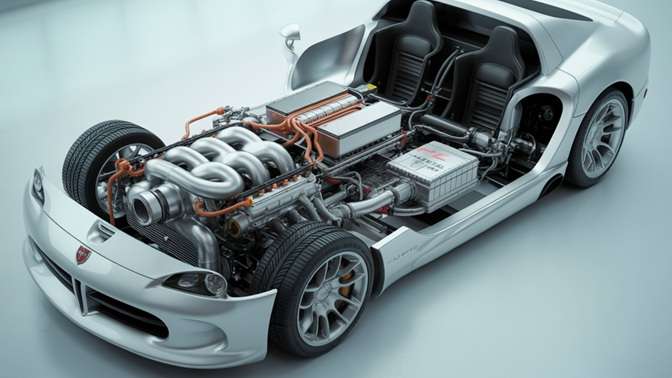
Scenario B: High‑output hybrid (most competitive overall)
- Layout: Hurricane I6 + P2 hybrid module (transmission‑integrated motor) or rear e‑motor add‑on
- Combined output: 650–750 hp
- Drivetrain: RWD with electric torque fill; ACR variant could add front e‑axle for torque‑vectoring AWD
- Electric range: Minimal (it’s a performance hybrid, not a commuter)
- Pros: Instant torque, faster lap consistency, lower emissions, tech halo
- Cons: Weight and cost increase; packaging complexity; “is a hybrid Viper still a Viper?” debates ensue
Scenario C: Low‑volume EV halo (least likely but possible)
- Platform: A bespoke or shortened STLA Large variant
- Output: 650–800+ hp dual‑motor
- Battery/system: 800V fast‑charge architecture
- Pros: Brutal acceleration, cool tech story, future‑proof image
- Cons: Heavy, expensive, and philosophically far from the Viper’s raw, analog roots
2026 Dodge Viper Specs
These are directional numbers to frame expectations if Dodge greenlights a Viper program.
| Category | ICE I6 (base) | Hybrid HO | EV Halo |
|---|---|---|---|
| Power | 520–560 hp | 650–750 hp (combined) | 650–800+ hp |
| Torque | 475–520 lb‑ft | 650–800 lb‑ft (system) | 700–900 lb‑ft (est.) |
| 0–60 mph | 3.3–3.6 s | 2.9–3.2 s | 2.5–3.0 s |
| Top speed | 195+ mph | 200+ mph | 190–200 mph (gearing-limited) |
| Curb weight | 3,300–3,450 lb | 3,550–3,800 lb | 4,200+ lb |
| Transmission | 6‑MT or 8‑DCT | 8‑DCT | 1‑speed |
| Drive | RWD | RWD (AWD optional ACR) | AWD |
| Brakes | 15–16 in iron | Carbon‑ceramic optional | Carbon‑ceramic std. |
| Aero | Fixed wing opt. | Active wing opt. | Active aero likely |
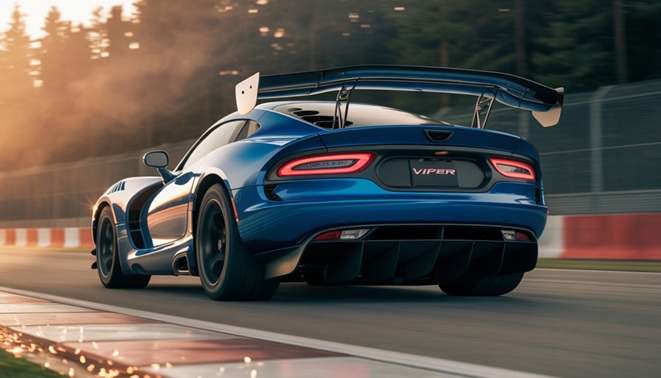
2026 Dodge Viper Features
Coil‑overs (manual adjust on track trims), spherical bushings, beefy anti‑roll bars, and track alignment settings from the factory. Splitters with endplates, underbody strakes, multi‑element rear wings, and brake‑cooling channels. Carbon‑ceramic availability, 305‑plus front and 345‑plus rear rubber on 19/20‑inch wheels. Minimal fluff—base modes for road/track/wet with configurable ABS/ESC thresholds. Built‑in lap timing, video capture, and telemetry exports via Uconnect 5 performance pages. Blind‑spot, rear cross‑traffic, front/rear parking sensors. No lane‑centering circus for the track rat crowd.
2026 Dodge Viper Interior
The old Viper wasn’t about coddling. A new one should keep that vibe but fix the headaches. Deep buckets (standard) with optional carbon shells for ACR, pass‑throughs for 6‑point harnesses. Alcantara wheel with center stripe, knurled metal knobs, exposed weave on high‑wear carbon. 12‑inch cluster with track‑first graphics; 10–12‑inch center screen with Uconnect 5, Apple CarPlay/Android Auto, and performance pages. Real switches for exhaust, wing angle presets (if active), dampers, and traction thresholds. Light, not loud—enough sound deadening to converse on the freeway, but no “luxury car” weight.
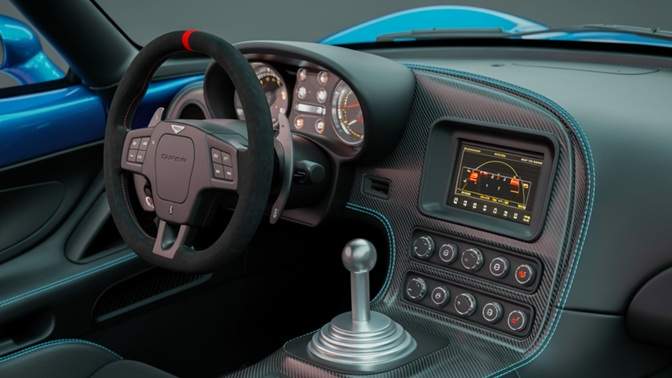
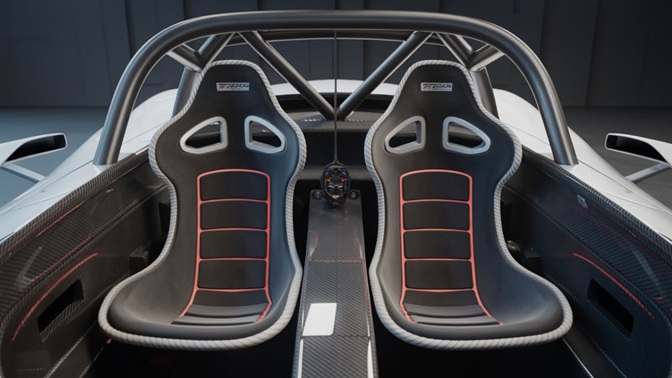
2026 Dodge Viper Colors (projected palette)
- Viper Red, Viper Bright Blue, Venom Black, Alpine White
- Snakeskin Green Pearl, Gunmetal Graphite, Competition Orange
- Heritage stripes: twin‑stripe options in white, black, or gunmetal
- ACR exclusives: matte clear over exposed carbon, day‑glow accent packages
2026 Dodge Viper Pricing Details
If Dodge is serious, it will land the Viper where it can challenge Corvette, 911, and track‑specials without trying to be a $300k exotic.
| Trim (projected) | Drivetrain | Target Price (USD) |
|---|---|---|
| Viper | I6 twin‑turbo, RWD | 110k–110k–120k |
| Viper GTS | I6 twin‑turbo HO or Hybrid | 125k–125k–140k |
| Viper ACR | Hybrid HO or ICE HO | 160k–160k–190k |
Note: Prices reflect 2026 dollars and the realities of low‑volume, high‑performance homologation.
2026 Dodge Viper Release date
Concept late 2025, production‑intent prototype early 2026, first customer cars mid‑to‑late 2026. Building a low‑volume supercar requires suppliers, tooling, and a plant plan. If Dodge proceeds, timing could slip into 2027+.
| Car | Powertrain | Power | 0–60 mph | Base Price |
|---|---|---|---|---|
| Chevy Corvette Z06 | 5.5L NA V8 | 670 hp | ~2.6–2.7 s | ~$114k |
| Porsche 911 Carrera S | 3.0L TT flat‑6 | 443 hp | ~3.3 s | ~$130k |
| Porsche 911 GT3 | 4.0L NA flat‑6 | 502 hp | ~3.2 s | ~$182k |
| Corvette E‑Ray | Hybrid V8 AWD | 655 hp | ~2.5 s | ~$106k |
| Nissan Z NISMO | 3.0L TT V6 | 420 hp | ~3.6–4.0 s | ~$66k |
| 2026 Dodge Viper (proj. Hybrid) | I6 TT + e‑assist | 650–750 hp | 2.9–3.2 s | 125k–125k–140k |
2026 Dodge Viper Buying Guide
If Dodge actually opens the order books, here’s how to play it.
Pick your poison (drivetrain)
- Purist: ICE I6 with a manual—lighter, more visceral, still seriously quick.
- Time‑attack hero: Hybrid HO—lap after lap consistency, torque fill, and better temps.
Decide your use‑case
- Track days 10+ times/year: ACR all day. You’ll use the aero, brakes, and data.
- Street + occasional track: Core Viper or GTS—lighter, simpler, and easier to live with.
Options worth it
- Carbon‑ceramic brakes: If you track or live in the mountains, they pay for themselves in fade resistance and rotor life.
- Bucket seats with pass‑throughs: If you’ll ever add a harness, get them now.
- Lift system (if offered): Saves splitters and your driveway.
Budget for the real costs
- Tires: Sticky 305/345 rubber isn’t cheap—budget 2k–2k–3k per full set, more for track compounds.
- Insurance: Quote early; VIN‑specific premiums vary wildly on low‑volume exotics.
- Consumables: Pads, rotors, fluids—track days eat them; plan accordingly.
Configurator strategy (if/when it exists)
- Keep it light: Choose the performance options you’ll use and skip the comfort fluff.
- Aero with intent: Big wings look cool, but pick packages you’ll leverage on track; otherwise, you’re hauling drag for Instagram.
- Color with history: Vipers wear stripes well. If you’ll keep it long term, go heritage—resale tends to smile on it.
Reality check: What could kill the project
- Compliance and cost: Meeting crash and emissions rules in tiny volumes is expensive.
- Brand bandwidth: Dodge is already launching Charger EV/ICE; adding a Viper risks resource stretch.
- Market math: A niche manual supercar is a passion project. Stellantis will want ROI, not just applause.
FAQ/Frequently Asked Questions
No. As of now, there’s no official program announcement.
Highly unlikely. Expect a twin‑turbo inline‑six, a hybrid, or—less likely—an EV.
A manual would be fan‑favorite, but a modern DCT is more likely for emissions and performance.
If the Viper returns, a hardcore track package is practically tradition. Expect one
Unclear. The old Viper plant is out; any revival would need a new plan and supplier web.
A 2026 Dodge Viper revival would be a goosebumps moment for American performance. But until Dodge says “go,” it’s a high‑octane what‑if. If it does happen, bet on a lighter, sharper Viper with real aero, massive brakes, and a powertrain that speaks 2026—be it a twin‑turbo six, a hybrid sledgehammer, or a low‑volume EV flex. Priced right, it could slide between Corvette and Porsche and bring back that proudly unpolished, race‑shop charisma only a Viper can. Until then, we’ll keep the fire suit ready and the rumor radar on.
Related Post




